#musée d'Archéologie Nationale
Photo

EXPOSITION | Le monde de Clovis ➽ https://france-pittoresque.com/spip.php?article16036 Comment vit-on autour de l’an 500 de notre ère ? Quelle importance prend le statut social sous Clovis ? Comment faire carrière dans un monde franc en transition ? Pour le découvrir, le musée d'Archéologie nationale propose une immersion, à mi-chemin entre jeu de rôle et exposition, dans le monde de Clovis et des Francs
2 notes
·
View notes
Text
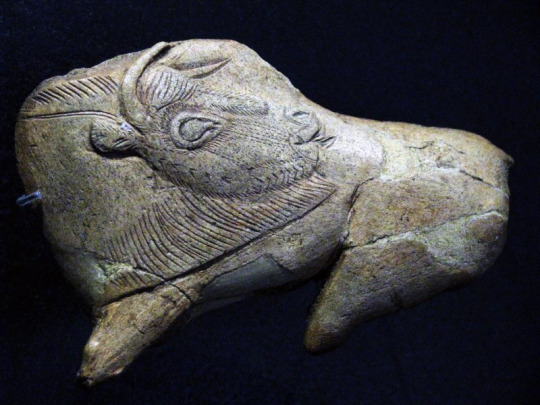
Placchetta con un bisonte. 13000 anni fa.
Conservata al Musée d'Archéologie Nationale di Saint - Germain - en - Laye presso Parigi
Da un corno di renna.
0 notes
Text
Autore: Anonimo
Nome dell’opera: Bisonte che lecca la puntuta di un insetto
Data: 13000 anni fa
Periodo:Paleolitico
Collocazione: Grotta di Abri de la Madeleine, Dordogna, Francia
Tecnica: Scaglia di corno di renna intagliata
Funzione: parte del manico di un propulsore
È conservata Musée d'Archéologie nationale et domaine national de Saint-Germain-en-Laye, Parigi, Francia

0 notes
Text

AUTORE: Anonimo NOME DELL'OPERA: Bisonte che lecca la puntuta di un insetto DATA: 13000 anni fa PERIODO: Paleolitico COLLOCAZIONE: Grotta di Abri de la Madeleine, Dordogna, Francia TECNICA: Scaglia di corno di renna intagliata FUNZIONE ORIGINALE: Forse era parte del manico di un propulsore COLLOCAZIONE ATTUALE: Musée d'Archéologie nationale et domaine national de Saint-Germain-en-Laye, Parigi, Francia
0 notes
Text
Les caractéristiques de la situation géographique et de la topographie

le climat favorable, la richesse du potentiel naturel, historique, culturel et touristique de l'Ukraine créent toutes les possibilités de satisfaction complète des besoins cognitifs, sanitaires, sportifs et spirituels des touristes nationaux et étrangers. Selon les données du Comité national des frontières, en 2001, 9,2 millions d'étrangers ont visité l'Ukraine à des fins touristiques.
Les régions touristiques les plus populaires sont la Crimée, la région de la mer Noire, la Transnistrie, la Podilliа et la Volyn, les villes de Kyiv, Odessa et Lviv. Ces centres de ressources naturelles, historiques et culturelles importantes sont les plus prometteurs pour l'organisation d'activités touristiques.
La fierté particulière du pays est son fonds de réserve naturelle, qui comprend environ 6 000 objets d'une superficie totale de 980 000 hectares, dont les plus importants sont la réserve de biosphère des Carpates, le parc naturel national des Carpates, le parc national de Shatsky, le Parc national de Synevir, réserve d'Askania. En Ukraine, il existe 200 000 monuments de culture, d'histoire, d'urbanisme et d'architecture, d'art de palais et de parc, d'archéologie, ainsi que 378 musées. Sept réserves nationales historiques et culturelles ont été créées. Les plus précieux sont les monuments de l'ère de Kyivan Rus (IX - XII siècles) - 80% des monuments de cette période sont concentrés sur le territoire de l'Ukraine, dont les plus importants - Kyiv-Pechersk Lavra et Sophia Cathedral - sont inscrits dans les registres de l'UNESCO.
#voyage#lesvues#pays#apprendlemonde#temps#bonjourvoyage#repos#joie#plaisir#environnementinconnu#faitsintéressants#finaguide
0 notes
Text
The gold hilted sword and knife of a Frankish chief, modern France, ca. 5th-6th century, housed at the Musée d'Archéologie Nationale.

#weapons#sword#migration era#gold#garnet#Europe#European#Francfrance#French#franks#frankish#musée d'Archéologie Nationale#art#history
244 notes
·
View notes
Photo
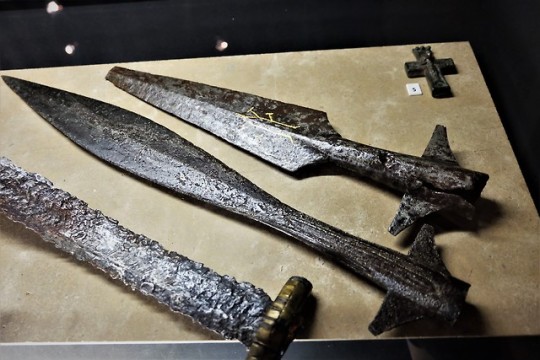

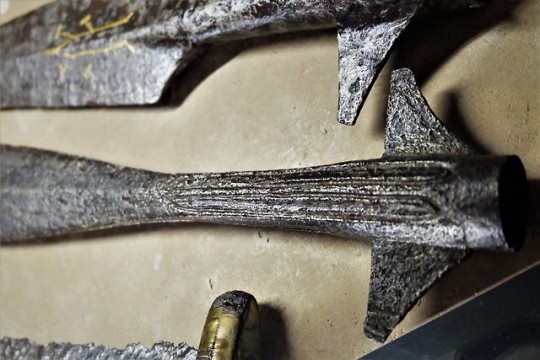
Carolingian Spearheads from France dated around the 9th Century on display at the Musée D'Archéologie Nationale in Paris, France
Some arms and armour from the Carolingian Empire have survived in the archaeological record but they are mainly swords or helmets, items that doubled as indication of status as well as for military use. Spears could be made en mass and distributed to large bodies of soldiers rather than more expensive swords. Invading Vikings often encountered “unarmed” commoners who were then slaughtered however some historians think this is because they were not properly equipped compared to the Scandinavian attackers.
Photographs taken by myself 2018
#medieval#military history#archaeology#frankish empire#carolingian#france#french#art#9th century#Château de Saint-Germain-en-Laye#Musée D'Archéologie Nationale#museum#paris#barbucomedie
327 notes
·
View notes
Note
Top 5 things to do in Paris
This is absolutely cheating because one of the things I listed isn’t in Paris, but I wanted to include my absolute favorite museum in the region. I know I’m forgetting some things, but it’s been awhile since I was living there, so this was my favorite per category off the top of my head!
1. Explore the Paris Catacombs
2. Eat at L’As du Fallafel
3. Take the train out to the Musée d'Archéologie nationale
4. Take an early morning walk in Bois de Boulogne to see Red Squirrels, Green Woodpeckers, Crested Tits and other western European specialties.
5. Get pastries at Du Pain et des Idées
33 notes
·
View notes
Photo

Bronze female wild boar
Gallo-Roman (ca. 58 BCE - 5th century CE)
Musée d'Archéologie Nationale
238 notes
·
View notes
Photo

"Souveraineté du Peuple"
La République, par Sébastien-Melchior Cornu (1804-1870)
#Sébastien-Melchior Cornu#La République#14 juillet#fête nationale#Liberté Égalité Fraternité (pour toutes et tous!)#France#drapeau français#bleu blanc rouge#La Marseillaise#allons enfants de la Patrie#Vive la République#Vive la France#old paintings#Musée des Beaux-Arts et d'Archéologie de Besançon
1 note
·
View note
Photo

Hoard of Neolithic polished axes (4000s BC), found in “Le Mouillarien” in the commune of Arzon (Bretagne, France). From the “Bernon Hoard”.
Several hundred large polished axes have been found in the region around Carnac (another commune in Bretagne). Most were found in large tombs from 4500 – 4000 BC that are scattered around the edge of the Gulf of Morbihan. They had been placed in burial chambers made of megalithic slabs, covered in huge mounds of earth and stones called “tumuli” or “cairns”.
Dr. de Closmadeuc, who acquired this collection in 1894, said of their discovery: “When breaking one of the large stones that seemed to have been intentionally arranged in a large circle, we discovered 17 stone axes...upright, the blade uppermost, one against another in a tight circle, and protected at the sides by a sort of dry stone wall, and covered with a flat stone.”
16 of the Bernon axes are held in the Musée d'Archéologie Nationale. Six are made of sillimanite, a local rock found in strata about 10km away from Arzon. The other ten are made of greenstone, which would have come from further away, probably from the Alps. The axes have been polished over their entire surface. Their lengths range from 15 – 28 cm.
#history#prehistory#geography#geology#neolithic period#france#prehistoric france#neolithic france#bretagne#morbihan#arzon#axes#sillimanite#greenstone
56 notes
·
View notes
Photo
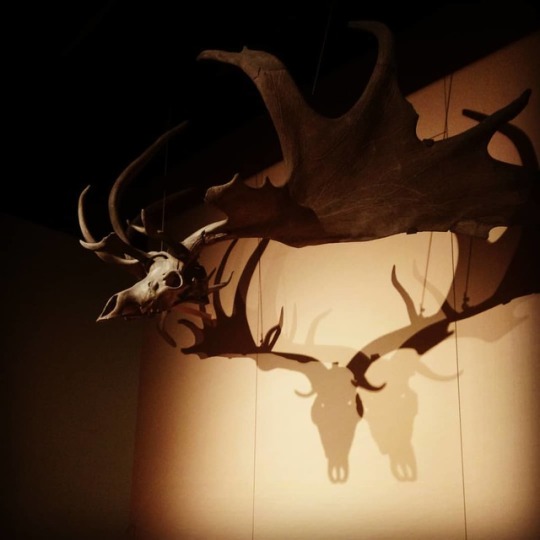
. . . . #megaloceros #prehistoire #museearcheologique #journeesdupatrimoine (à Musée d'Archéologie nationale et Domaine national de Saint-Germain-en-Laye) https://www.instagram.com/p/B2rsfvZiqVOKk9DhjUDGKD5UaKzunFctcGSgCU0/?igshid=qw6cvyx4vfwf
13 notes
·
View notes
Photo
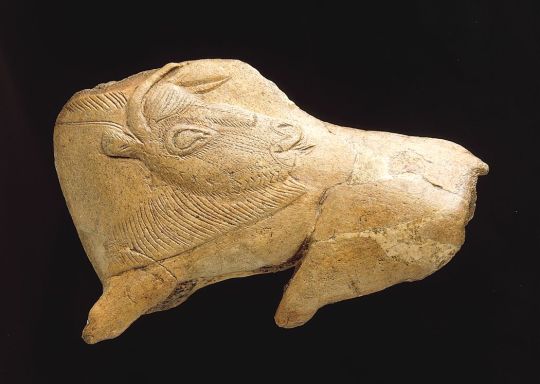

Placchetta di bisonte, ca. 13000 anni fa. Scaglia di corno di renna lavorata, Musée d'Archéologie Nationale di Saint-Germain-en-Laye, Musée d'Archeologie nationale.
2 notes
·
View notes
Text

Lezione del 28/09/2019
Nome🏵: Placchetta con un bisonte.
Autore🏵: Sconosciuto.
Data🏵: 13000 anni fa (paleolitico).
Materiale e tecnica🏵: È forse stato ricavato da un corno di renna e poi inciso.
Contesto originale🏵:Possiamo ipotizzare facesse parte del manico di un propulsore.
Luogo di ritrovamento🏵: La-Madeleine.
Collocazione attuale🏵: Musée d'Archéologie Nationale di Saint-Germain-en-Laye presso Parigi.

Figurina di mammut:
Nome🏵: Figurina di mammut.
Autore🏵: Sconosciuto.
Data🏵: 3500 anni fa.
Materiale e tecnica🏵: Avorio scolpito a tutto tondo.
Ritrovamento🏵: Vogelheard, Germania.
2 notes
·
View notes
Text

Autore sconosciuto
Placchetta con bisonte
13000 anni fa
Scaglia di corno di renna
Musée d'Archéologie Nationale di Saint Germain en Laye, Parigi, Francia
1 note
·
View note
Text

Placchetta con un bisonte
13000 anni fa
a La-Madeleine
Ricavata da una scaglia di corno di renna, faceva forse parte del manico di un propulsore
è conservata al Musée d'Archéologie Nationale di Saint -Germain - en - Laye presso Parigi.
1 note
·
View note